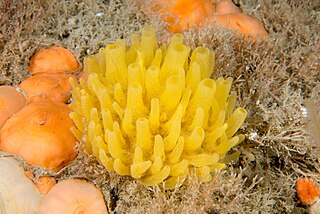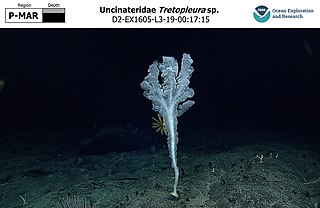
Polymastia is a genus of sea sponges containing about 30 species. These are small to large encrusting or dome-shaped sponges with a smooth surface having many teat-shaped projections (papillae). In areas of strong wave action, this genus does not grow the teat structures, but instead grows in a corrugated form.

Lyssacinosida is an order of glass sponges (Hexactinellida) belonging to the subclass Hexasterophora. These sponges can be recognized by their parenchymal spicules usually being unconnected, unlike in other sponges in the subclass where the spicules form a more or less tightly connected skeleton. Lyssacine sponges have existed since the Upper Ordovician, and three families are still alive today. The Venus' flower basket is one of the most well-known and culturally significant of the glass sponges.

Euplectellidae is a family of glass sponges (Hexactinellids) belonging to the order Lyssacinosa, first represented in the Ordovician fossil record, substantially older than molecular estimates of the clade's age.

Rossellidae is a family of glass sponges belonging to the order Lyssacinosa. The family has a cosmopolitan distribution and is found at a large range of depths.

Caulophacus is a genus of glass sponges belonging to the subfamily Lanuginellinae.
Acanthascus is a genus of sponges in the family Rossellidae. Species include:

Mycale is a genus of demosponge with 240 recognised species in 11 subgenera. It has been a large genus with multiple subdivisions since it was first described in 1867.
Sceptrulophora is an order of hexactinellid sponges. They are characterized by sceptrules, a type of microsclere with a single straight rod terminating at a bundle of spines or knobs. An anchor- or nail-shaped sceptrule is called a clavule. A fork-shaped sceptrule, ending at a few large tines, is called a scopule. A broom-shaped sceptrule, ending at many small bristles, is called a sarule.

Farreidae is a family of glass sponges in the order Sceptrulophora.

Farrea is a genus of glass sponges in the family Farreidae.

Euretinae is a subfamily of glass sponges in the family Euretidae.

Aspidoscopulia is a genus of glass sponge in the family Farreidae.

Uncinateridae is a family of glass sponges in the order Sceptrulophora.
Claviscopulia is a genus of glass sponge in the family Farreidae.

Bolosoma is a genus of pedunculated siliceous sponges belonging to the family Euplectellidae. This genus lives in deep-sea environments and provides a habitat for a plethora of other benthic species, giving Bolosoma an incredibly important ecological role in the ecosystems it is a part of.
Lychniscosida is an order of sponges belonging to the class Hexactinellida and subclass Hexasterophora. They are dictyonal sponges characterized by the presence of additional struts at the nodes of the skeleton. These struts create octahedral frames, known as lychniscs ("lanterns").
Diapleuridae is a family of glass sponges in the order Lychniscosida. The only living species, Scleroplegma lanterna, is endemic to the waters around Cuba and St. Croix in the Caribbean Sea.

Rosella is a genus of glass sponges in the family Rossellidae. It is found in the Antarctic and sub-Antarctic regions.
Rossella antarctica is a relatively small species of glass sponge. It is widely distributed in the southern hemisphere, particularly in the Antarctic and sub-Antarctic regions.














